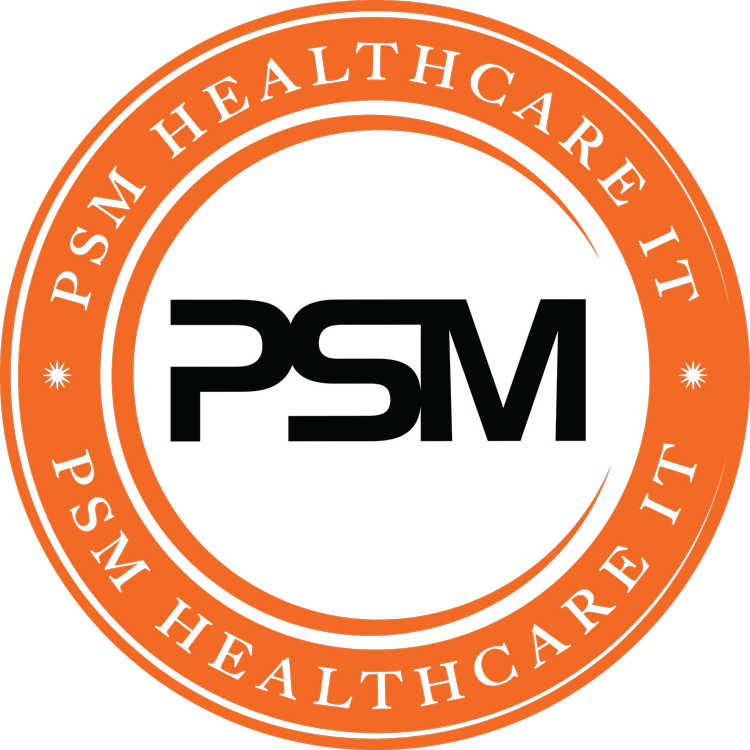PSM Healthcare IT- Modesto
Welcome to PSM Healthcare Information Technology, your trusted IT solutions provider in Modesto. We specialize in delivering advanced technology solutions tailored for the healthcare sector, ensuring your operations are seamless, efficient, and secure.
Our Services
Electronic Health Records (EHR) Systems Streamline patient data management with our advanced EHR systems. We help healthcare providers in Modesto transition smoothly to digital records.
Healthcare IT Consulting Our expert consultants provide strategic advice to optimize your IT infrastructure, ensuring compliance with the latest healthcare regulations and standards.
Data Security and Compliance Protect patient information with our robust security solutions. We ensure your systems are compliant with HIPAA and other relevant regulations.
Telemedicine Solutions Expand your reach and improve patient care with our telemedicine platforms. We provide the technology to connect healthcare providers and patients remotely.
Network Infrastructure Build a reliable and scalable IT network with our infrastructure solutions. We design and implement networks that support the unique needs of healthcare facilities in Modesto.
Why Choose Us?
Expertise in Healthcare IT With years of experience in the healthcare industry, we understand the unique challenges and requirements of healthcare IT.
Customized Solutions We tailor our services to meet the specific needs of your organization, ensuring the best fit for your IT environment.
Proven Track Record Our team has a history of successful projects and satisfied clients in Modesto and beyond.
Healthcare IT in Modesto is transforming how medical services are delivered with breakthroughs and innovation in web systems. With advanced technology, local hospitals and clinics are improving patient care and streamlining operations. This shift enhances efficiency and ensures better data management. Providers are adopting electronic health records, telemedicine, and cybersecurity measures to protect sensitive information. These innovations not only save time but also improve communication between patients and healthcare professionals.
Discover the top solutions that are making waves in the industry. From software to hardware, we’ll cover the best options available in Modesto. Get ready to explore the latest trends and tools that can elevate healthcare services in your area. Scroll down for reviews of our top picks!
Key Takeaways
Explore AI-powered diagnostics to improve accuracy in patient assessments, helping healthcare providers make better decisions.
Consider integrating telemedicine platforms to enhance patient access and convenience, especially for routine check-ups and follow-ups.
Implement remote patient monitoring solutions to keep track of patients’ health from home, reducing hospital visits and improving outcomes.
Invest in wearable health technology that allows patients to monitor their vital signs and share data with their doctors in real time.
Utilize IoT medical devices to streamline patient care and gather valuable data for better treatment plans.
Look into blockchain health records for secure and efficient management of patient information, ensuring privacy and trust.
1. AI-Powered Diagnostics
AI-powered diagnostics enhance accuracy in disease detection. These systems utilize artificial intelligence and machine learning algorithms to analyze vast amounts of patient data quickly. For example, the Brain Initiative leverages advanced analytics to identify early signs of diseases like Alzheimer’s. This allows healthcare providers to intervene sooner, potentially improving patient outcomes.
The technology streamlines the diagnostic process by processing data from multiple sources. It can analyze medical histories, lab results, and imaging studies in a fraction of the time it would take a human. This rapid analysis reduces human error, which is crucial in critical situations. Predictive analytics further improves outcomes by identifying potential health problems before they escalate.
Access to valuable information is another key feature of AI diagnostics. Healthcare professionals can gain insights that were previously difficult to obtain. By utilizing data effectively, these systems provide actionable recommendations for treatment options tailored to individual patients.
Moreover, AI can manage anonymous site visitation data to improve healthcare services without compromising patient privacy. This ensures that institutions can still gather necessary insights while adhering to ethical standards regarding patient information.
In summary, AI-powered diagnostics represent a significant advancement in healthcare IT. They not only streamline processes but also enhance the quality of care provided to patients through improved accuracy and reduced errors.
2. Telemedicine Platforms
Telemedicine platforms expand access to healthcare services for patients in remote areas. They bridge the gap between healthcare providers and patients, allowing individuals who may not have easy access to medical facilities to receive necessary care from the comfort of their homes.
These platforms facilitate real-time consultations. Patients can connect with healthcare professionals through video calls or chat features. This immediate interaction helps in diagnosing issues quickly and efficiently. According to a report by the American Telemedicine Association, over 75% of patients express satisfaction with telehealth visits, indicating that these services meet their needs effectively.
Patient engagement improves significantly through convenient virtual visits. Many telemedicine platforms incorporate user-friendly interfaces and mobile applications. This accessibility encourages more patients to seek medical advice when needed. Telemedicine can reduce wait times and travel costs associated with traditional in-person visits.
Marketing plans for telehealth services often leverage social media to reach a broader audience. Engaging potential patients through targeted ads and informative content increases awareness about available services. Collaborations with local health partners further enhance service visibility and credibility.
In summary, telemedicine platforms play a crucial role in modern healthcare by making services more accessible and convenient for patients, leading to improved satisfaction and engagement overall.
3. Remote Patient Monitoring
Remote Patient Monitoring (RPM) enables continuous tracking of patient health metrics from the comfort of their homes. This technology allows patients to use devices that collect vital signs and other health data, which is then transmitted to healthcare providers in real-time.
Healthcare providers can intervene early based on this real-time data. For example, if a patient’s blood pressure spikes, doctors can contact them immediately to adjust medications. This proactive approach helps manage chronic conditions more effectively.
Studies show RPM can significantly reduce hospital readmission rates. Patients with chronic diseases like diabetes or heart failure benefit most from RPM. According to a report by the American Telemedicine Association, RPM can lower readmission rates by up to 30%.
The conditional marketing authorization for some RPM devices highlights their growing importance in healthcare. These devices must meet strict regulatory standards before they are approved for use. This ensures that patients receive safe and effective monitoring solutions.
RPM also enhances individual health management. Patients feel empowered as they take charge of their health through self-monitoring tools. This leads to improved health outcomes and higher patient satisfaction.
In summary, Remote Patient Monitoring transforms how healthcare is delivered by enabling ongoing assessment and timely interventions, ultimately benefiting both patients and providers alike.
4. Wearable Health Tech
Wearable health tech includes devices like fitness trackers and smartwatches that collect real-time health data. These technologies monitor vital signs such as heart rate, blood pressure, and activity levels.
Consumer adoption of wearable health tech has surged in recent years. A report from the World Economic Forum indicates that over 50% of consumers are using some form of wearable device for health tracking. This shift aligns with growing consumerist urges for personalized health management.
Wearable devices encourage proactive health management through personalized feedback. For example, many devices provide alerts when users reach unhealthy levels of physical activity or need to take a break. This real-time feedback promotes greater awareness about personal health.
These technologies foster greater patient responsibility for their health. Users can track their progress and set personal health goals, making them more engaged in their wellness journey. Social media platforms like Facebook have also played a role in this trend by allowing users to share their health achievements, creating a supportive community around fitness and wellness.
In summary, wearable health tech transforms how individuals manage their health. It empowers users by providing essential data and encourages responsible health practices through active engagement. The increasing consumer adoption highlights its significance in modern healthcare trends.
5. IoT Medical Devices
IoT medical devices connect to the internet for seamless data exchange. These devices collect real-time health information, which healthcare providers can access remotely. This technology allows for better monitoring of disease progression and more timely interventions.
These smart devices improve operational efficiency in healthcare facilities. For example, hospitals can use connected devices to track inventory levels, ensuring that essential supplies are always available. This reduces waste and saves costs.
Patient safety enhances through automated alerts for critical health changes. For instance, a device monitoring glucose levels in people with diabetes can send immediate notifications if levels drop dangerously low. This feature enables quicker responses from healthcare providers, potentially saving lives.
Statistics show that IoT medical devices can significantly reduce hospital readmission rates. A study found that using remote monitoring reduced readmissions by up to 30%. This statistic highlights how these devices positively impact patient outcomes.
Moreover, consumers benefit from increased control over their health data. Wearable devices allow individuals to track vital signs and manage their health proactively. This empowerment leads to healthier lifestyles and better management of chronic conditions.
In summary, IoT medical devices transform healthcare by improving efficiency and enhancing patient safety. They provide critical support in managing diseases and empower consumers to take charge of their health.
6. Blockchain Health Records
Blockchain health records secure patient data with decentralized storage. This technology prevents unauthorized access to personal information, ensuring that only authorized parties can view sensitive data.
Interoperability among healthcare systems improves significantly with blockchain. Traditional systems often struggle to share data efficiently. However, blockchain allows seamless integration across platforms. This leads to better communication and collaboration in public health efforts.
Patients gain enhanced control over their health information through blockchain. They can manage consent for who accesses their records. This empowers individuals to make informed decisions about their personal information.
Statistics show that healthcare organizations can save up to 30% on operational costs by adopting blockchain solutions. A survey revealed that 70% of patients prefer a system that gives them more control over their data. These numbers highlight the growing demand for secure and user-friendly health record management.
Privacy policies are crucial in this digital age. Blockchain ensures transparency while protecting sensitive data. It also aligns with cookie declaration pages that inform users about how their data is used online.
In summary, blockchain health records offer a unique solution to enhance privacy, interoperability, and patient autonomy in healthcare IT. The potential benefits make it a vital consideration for future developments in the industry.
7. Cloud-Based Healthcare Systems
Cloud-based healthcare systems offer scalable solutions for storing and managing healthcare data. These systems allow organizations to expand their storage needs without significant infrastructure investments.
Collaboration among healthcare providers improves through shared access to patient information. This accessibility enables timely decisions, especially in critical situations involving diseases like the flu. Providers can quickly share sensitive information, ensuring comprehensive care for patients.
Data backup and recovery features enhance system reliability and security. In case of a cyber incident or data loss, cloud systems can restore information efficiently. This capability is crucial for maintaining patient trust and complying with regulations.
The economic benefits of cloud-based systems are notable as well. Organizations save on physical storage costs and reduce the need for extensive IT support teams. Many cloud services also provide flexible pricing models, allowing healthcare facilities to pay only for what they use.
These systems promote convenience by enabling access from secure websites. Healthcare providers can log in from various devices, facilitating remote consultations and improving patient engagement. Support communities around these platforms help users troubleshoot issues and share best practices.
8. Precision Medicine Tools
Precision medicine tools tailor treatment plans based on individual genetic profiles and health data. These tools analyze a patient’s unique genetic makeup to determine the most effective treatment options. This approach enhances the chances of successful outcomes while minimizing adverse effects.
By utilizing gene editing technologies, precision medicine can target specific genes responsible for diseases. For instance, researchers have developed therapies that modify immune cells to better fight cancer. This leads to more effective treatments that are customized for each patient’s needs.
Drug efficacy improves significantly with precision medicine. Traditional methods often lead to one-size-fits-all treatments, which can result in unwanted side effects. Personalized therapies consider variations in genes, allowing for safer and more effective medication.
The integration of genomic data into clinical practices also advances research. By collecting and analyzing large datasets from various patients, researchers can identify patterns that lead to new cures. For example, studies show that understanding how different tissues respond to drugs can help design better therapies.
Statistics reveal a growing trend in precision medicine adoption. According to a report by the National Institutes of Health, over 70% of healthcare providers now use some form of personalized medicine in their practices.
9. Virtual Reality Therapy
Virtual Reality Therapy (VRT) uses immersive experiences to treat mental health conditions like PTSD and anxiety. This innovative approach allows patients to confront their fears in a controlled environment. Research shows that VRT can significantly reduce symptoms. For instance, a study by the American Psychological Association found that 90% of participants experienced relief from anxiety after completing a virtual treatment course.
VRT enhances rehabilitation programs through engaging virtual environments. Patients recovering from injuries can practice movements in a safe space, which improves their overall performance. These simulations help facilitate faster healing by allowing individuals to engage in physical therapy without the fear of real-world pain or injury.
Healthcare professionals benefit from VRT as well. Training simulations improve skills and decision-making under pressure. A study conducted by Stanford University revealed that medical students who participated in VR training performed 30% better in real-life scenarios compared to those who did not. This technology prepares them for complex situations they may encounter in practice.
Privacy remains a crucial factor in VRT. Ensuring patient consent and data protection is vital for building trust. As this technology evolves, it will likely change how we approach mental health treatments and rehabilitation.
10. Robotic Surgery Advancements
Robotic surgery advancements transform how medical professionals perform procedures. These innovations increase precision in surgical techniques, allowing for more accurate operations. Surgeons can control robotic arms with great dexterity, leading to better outcomes.
Minimally invasive techniques are a significant breakthrough in this field. They reduce recovery time and complications for patients. For example, robotic-assisted surgeries for prostate cancer often result in shorter hospital stays and quicker returns to normal activities. Studies show that patients experience less pain and fewer infections compared to traditional methods.
The technology expands surgical capabilities, especially in complex cases. Surgeons can navigate difficult anatomical structures with enhanced visualization and control. This advantage is particularly notable in surgeries involving spinal cord injuries. The precision offered by robotic systems allows for safer interventions in delicate areas.
Over the past decade, these advancements have rapidly evolved. Hospitals are increasingly adopting robotic systems due to their effectiveness and the huge convenience they provide. More than 1 million robotic surgeries occur annually worldwide, demonstrating their growing acceptance within the healthcare community.
Observaciones finales
The healthcare IT landscape in Modesto is evolving rapidly. From AI diagnostics to robotic surgery, these innovations are set to enhance patient care and streamline operations. Embracing these technologies means better health outcomes for you and your community.
Stay ahead of the curve. Explore how these advancements can transform your healthcare experience. Engage with local providers and tech companies to leverage these tools for your benefit. Your health matters, and with the right resources, you can take charge of it today.
Frequently Asked Questions
What is AI-Powered Diagnostics?
AI-powered diagnostics use artificial intelligence to analyze medical data and improve accuracy in disease detection. This technology enhances decision-making and speeds up diagnosis, benefiting both healthcare providers and patients.
How do Telemedicine Platforms work?
Telemedicine platforms connect patients with healthcare providers via video calls or messaging. They offer convenience, reduce travel time, and ensure timely access to care, making healthcare more accessible for everyone.
What are the benefits of Remote Patient Monitoring?
Remote patient monitoring allows healthcare professionals to track patients’ health metrics from home. This leads to early intervention, better management of chronic conditions, and enhanced patient engagement in their own health.
How does Wearable Health Tech contribute to wellness?
Wearable health tech monitors vital signs like heart rate and activity levels. It empowers users to take charge of their health, promotes proactive lifestyle changes, and provides valuable data for healthcare providers.
What role do IoT Medical Devices play in healthcare?
IoT medical devices collect and transmit patient data in real-time. This connectivity improves patient outcomes through timely interventions and enhances overall efficiency in healthcare delivery.
Why is Blockchain important for Health Records?
Blockchain technology secures health records through decentralized storage. It ensures data integrity, enhances privacy, and enables seamless sharing among authorized parties, fostering trust in electronic health information systems.
How do Cloud-Based Healthcare Systems improve efficiency?
Cloud-based healthcare systems streamline data management and enhance collaboration among providers. They reduce IT costs, allow for easy access to patient records, and support scalability as healthcare needs grow.





